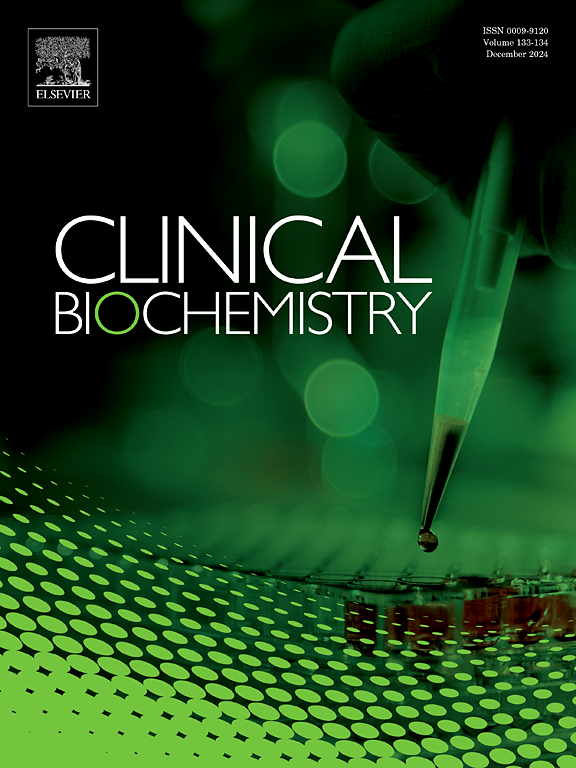The predictive value of ferroptosis marker SLC7A11 in the prognosis of advanced non-small cell lung cancer patients
IF 2.1
3区 医学
Q2 MEDICAL LABORATORY TECHNOLOGY
引用次数: 0
Abstract
Objective
This study aimed to evaluate the prognostic value of serum solute carrier family 7 member 11 (SLC7A11), a key regulator of ferroptosis, in patients with advanced non-small cell lung cancer (NSCLC).
Methods
A prospective observational study was conducted on 142 patients diagnosed with stage IIIB or IV NSCLC. Serum SLC7A11 levels, along with traditional tumor markers including carcinoembryonic antigen (CEA), cytokeratin 19 fragment (CYFRA 21-1), cancer antigen 125 (CA125), and cancer antigen 15–3 (CA15-3), were measured using enzyme-linked immunosorbent assay (ELISA). Patients were followed for one year, and demographic, clinical, and survival data were collected. The required sample size was calculated a priori using standard statistical methods. Statistical analyses, including receiver operator characteristic (ROC) curve analysis with bootstrap internal validation and Kaplan-Meier survival curves, were performed to assess the predictive value of SLC7A11.
Results
The non-survivors group (n = 91) exhibited significantly higher serum SLC7A11 levels compared to the survivors group (n = 51). Pearson correlation analysis indicated a positive correlation between serum SLC7A11 and serum CYFRA 21-1 levels. ROC analysis demonstrated that SLC7A11, particularly when combined with CYFRA 21-1, had significant predictive value for poor prognosis. Kaplan-Meier analysis revealed that patients with lower SLC7A11 levels had significantly longer overall survival. Multivariate logistic regression identified SLC7A11 and CYFRA 21-1 as independent risk factors for poor prognosis.
Conclusion
Serum SLC7A11 was a promising prognostic biomarker for advanced NSCLC, with elevated levels strongly associated with poor one-year survival outcomes. The combination of SLC7A11 with traditional markers enhanced predictive accuracy, offering potential for improved risk stratification and personalized treatment strategies in advanced NSCLC patients.
铁下垂标志物SLC7A11对晚期非小细胞肺癌患者预后的预测价值
目的探讨血清溶质载体家族7成员11 (SLC7A11)在晚期非小细胞肺癌(NSCLC)患者中的预后价值。SLC7A11是铁凋亡的关键调控因子。方法对142例IIIB或IV期非小细胞肺癌患者进行前瞻性观察研究。采用酶联免疫吸附试验(ELISA)测定血清SLC7A11水平,以及传统的肿瘤标志物包括癌胚抗原(CEA)、细胞角蛋白19片段(CYFRA 21-1)、癌抗原125 (CA125)和癌抗原15-3 (CA15-3)。患者随访一年,收集人口统计学、临床和生存数据。所需样本量采用标准统计方法先验计算。采用统计学分析,包括采用bootstrap内部验证的receiver operator characteristic (ROC)曲线分析和Kaplan-Meier生存曲线来评估SLC7A11的预测价值。结果非幸存者组(n = 91)血清SLC7A11水平明显高于幸存者组(n = 51)。Pearson相关分析显示血清SLC7A11与血清CYFRA 21-1水平呈正相关。ROC分析表明,SLC7A11,特别是与CYFRA 21-1联合使用时,对不良预后具有显著的预测价值。Kaplan-Meier分析显示,SLC7A11水平较低的患者总生存期明显较长。多因素logistic回归发现SLC7A11和CYFRA 21-1是预后不良的独立危险因素。结论血清SLC7A11是晚期非小细胞肺癌的预后生物标志物,其水平升高与较差的1年生存结果密切相关。SLC7A11与传统标志物的结合提高了预测准确性,为晚期NSCLC患者提供了改善风险分层和个性化治疗策略的潜力。
本文章由计算机程序翻译,如有差异,请以英文原文为准。
求助全文
约1分钟内获得全文
求助全文
来源期刊

Clinical biochemistry
医学-医学实验技术
CiteScore
5.10
自引率
0.00%
发文量
151
审稿时长
25 days
期刊介绍:
Clinical Biochemistry publishes articles relating to clinical chemistry, molecular biology and genetics, therapeutic drug monitoring and toxicology, laboratory immunology and laboratory medicine in general, with the focus on analytical and clinical investigation of laboratory tests in humans used for diagnosis, prognosis, treatment and therapy, and monitoring of disease.
 求助内容:
求助内容: 应助结果提醒方式:
应助结果提醒方式:


